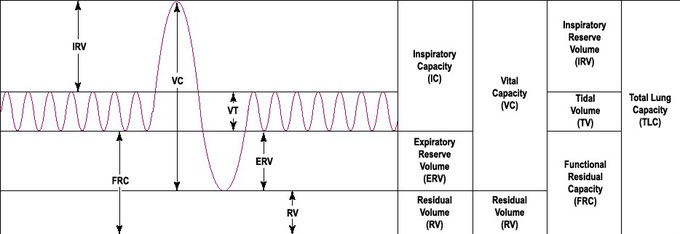21.5D: Breathing Patterns
Breathing patterns refer to the respiratory rate, which is defined as the frequency of breaths over a period of time, as well as the amount of air cycled during breathing (tidal volume). Breathing patterns are an important diagnostic criteria for many diseases, including some which involve more than the respiratory system itself.
Characteristics of the Breathing Patterns
The respiratory rate is frequency of breaths over time. The time period is variable, but usually expressed in breaths per minute because it that time period allows for estimation of minute ventilation. During normal breathing, the volume of air cycled through inhalation and exhalation is called tidal volume (VT), and is the amount of air exchanged in a single breath. Tidal volume multiplied by the respiratory rate is minute ventilation, which is one of the most important indicators of lung function. In an average human adult, the average respiratory rate is 12 breaths per minute, with a tidal volume of .5 liters and a minute ventilation of 6 liters per minute, though these numbers vary from person to person. Infants and children have considerably higher respiratory rates than adults.

Spirometry curve: The normal respiratory rate refers to the cyclical inhalation and exhalation of tidal volume (VT).
The respiratory rate is controlled by involuntary processes of the autonomic nervous system. In particular, the respiratory centers of the medulla and the pons control the overall respiratory rate based on a variety of chemical stimuli from within the body. The hypothalamus can also influence the respiratory rate during emotional and stress responses.
Normal and Altered Breathing Patterns
Eupnea is the term for the normal respiratory rate for an individual at rest. Several other terms describe abnormal breathing patterns that are indicative of symptoms of many diseases, many of which aren’t mainly respiratory diseases. Some of the more common terms for altered breathing patterns include:
- Dyspnea: commonly called shortness of breath. It describes dramatically decreased tidal volume and sometimes increased respiratory rate, leading to a sensation of breathlessness. It is a common symptom of anxiety attacks, pulmonary embolisms, heart attacks, and emphysema, among other things.
- Hypernea: refers to increased volume of air cycled to meet the body’s metabolic needs, which may or may not involve a change in frequency of breathing. It is a symptom of exercise and adjustment to high altitude, which are generally not problematic, but can also be seen in those with anemia or septic shock, which is problematic.
- Tachypnea: describes increased respiratory rate. Often a symptom of carbon monoxide poisoning or pnuemonia.
- Bradypnea: describes decreased respiratory rate. Often a symptom of hypertension, heart arryhmias, or slow metabolic rate from hypothyroidism.
- Apnea: Transient stopped breathing that begins again soon afterwards. It is the main symptom of sleep apnea, in which breathing temporarily stops during sleep.
These terms all describe an altered breathing pattern through increased or decreased (or stopped) tidal volume or respiratory rate. It is important to distinguish these terms from hyperventilation and hypoventilation, which refer to abnormalities in alveolar gas exchange (and thus blood pH) instead of an altered breathing pattern, but they may be associated with an altered breathing pattern. For example dyspnea or tachypnea often occur together with hyperventilation during anxiety attacks, though not always.
LICENSES AND ATTRIBUTIONS
CC LICENSED CONTENT, SHARED PREVIOUSLY
- Pulmonary ventilation. Provided by: Wikipedia. Located at: en.Wikipedia.org/wiki/Pulmonary_ventilation. License: CC BY-SA: Attribution-ShareAlike
- Modes of mechanical ventilation. Provided by: Wikipedia. Located at: en.Wikipedia.org/wiki/Modes_of_mechanical_ventilation%23Pressure_controlled. License: CC BY-SA: Attribution-ShareAlike
- ventilation. Provided by: Wiktionary. Located at: en.wiktionary.org/wiki/ventilation. License: CC BY-SA: Attribution-ShareAlike
- Respiratory physiology. Provided by: Wikipedia. Located at: en.Wikipedia.org/wiki/Respiratory_physiology. License: CC BY-SA: Attribution-ShareAlike
- Inhalation. Provided by: Wikipedia. Located at: en.Wikipedia.org/wiki/Inhalation. License: CC BY-SA: Attribution-ShareAlike
- negative pressure. Provided by: Wiktionary. Located at: en.wiktionary.org/wiki/negative_pressure. License: CC BY-SA: Attribution-ShareAlike
- inspiration. Provided by: Wiktionary. Located at: en.wiktionary.org/wiki/inspiration. License: CC BY-SA: Attribution-ShareAlike
- The respiratory system. Provided by: Wikibooks. Located at: en.wikibooks.org/wiki/Human_Physiology/The_respiratory_system. Project: Human Physiology. License: CC BY-SA: Attribution-ShareAlike
- Respiratory system. Provided by: Wikipedia. Located at: en.Wikipedia.org/wiki/Respiratory_system. License: CC BY-SA: Attribution-ShareAlike
- Exhalation. Provided by: Wikipedia. Located at: en.Wikipedia.org/wiki/Exhalation. License: CC BY-SA: Attribution-ShareAlike
- exhalation. Provided by: Wiktionary. Located at: en.wiktionary.org/wiki/exhalation. License: CC BY-SA: Attribution-ShareAlike
- Respiratory system. Provided by: Wikipedia. Located at: en.Wikipedia.org/wiki/Respiratory_system. License: CC BY-SA: Attribution-ShareAlike
- Thoracic diaphragm. Provided by: Wikipedia. Located at: en.Wikipedia.org/wiki/Thoracic_diaphragm. License: CC BY-SA: Attribution-ShareAlike
- Breathing. Provided by: Wikipedia. Located at: en.Wikipedia.org/wiki/Breathing. License: CC BY-SA: Attribution-ShareAlike
- Control of respiration. Provided by: Wikipedia. Located at: en.Wikipedia.org/wiki/Control_of_respiration. License: CC BY-SA: Attribution-ShareAlike
- breathing. Provided by: Wiktionary. Located at: en.wiktionary.org/wiki/breathing. License: CC BY-SA: Attribution-ShareAlike
- Lung Volume. Authored by: Vihsadas. Provided by: Wikimedia. Located at: commons.wikimedia.org/wiki/File:LungVolume.jpg. License: Public Domain: No Known Copyright
- Curation and Revision. Authored by: Boundless.com. Provided by: Boundless.com. License: CC BY-SA: Attribution-ShareAlike
21.5D: Breathing Patterns is shared under a CC BY-SA license and was authored, remixed, and/or curated by LibreTexts.
- Back to top
- 21.5C: Expiration
- 21.6: Factors Affecting Pulmonary Ventilation
- Was this article helpful?
- Yes
- No


